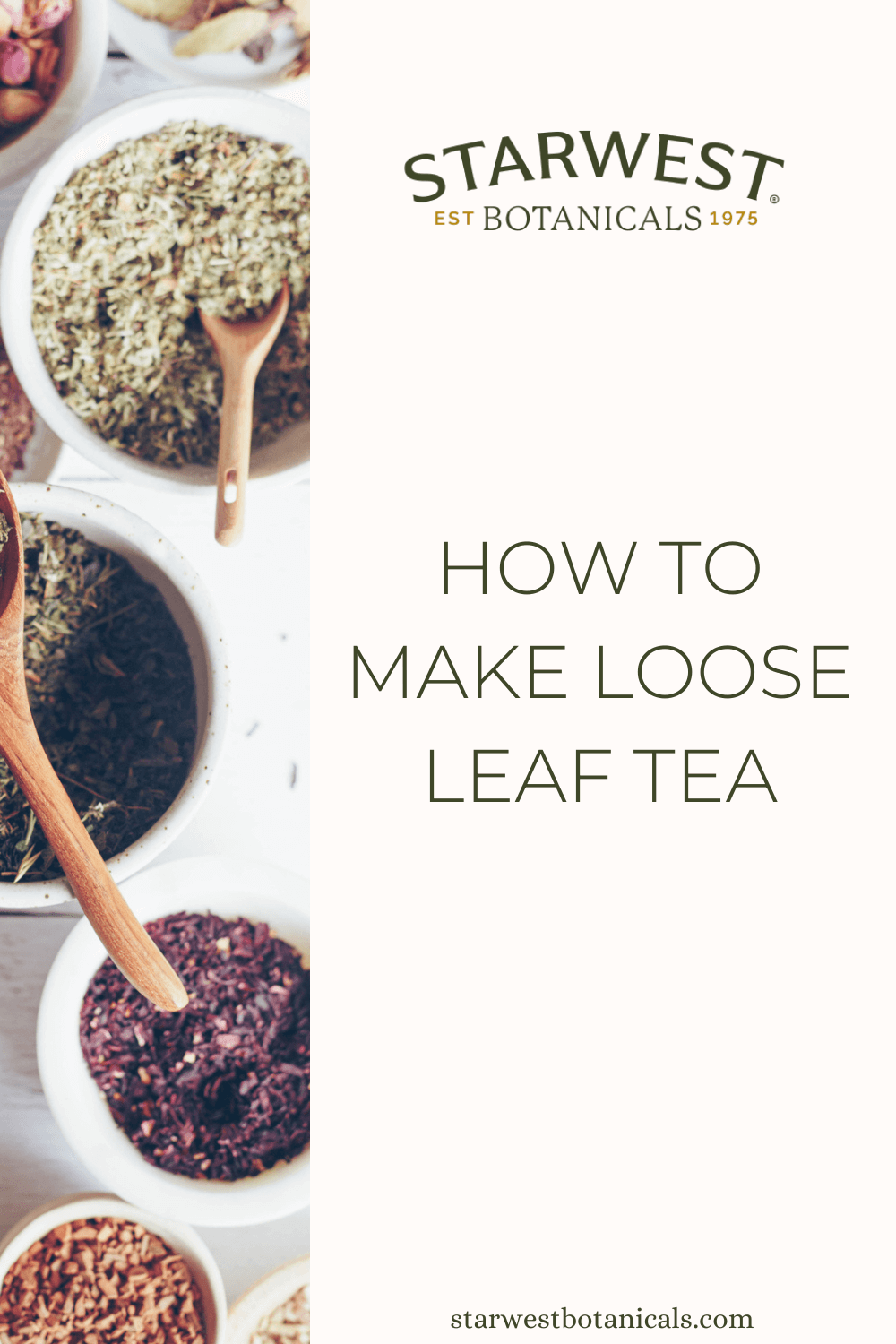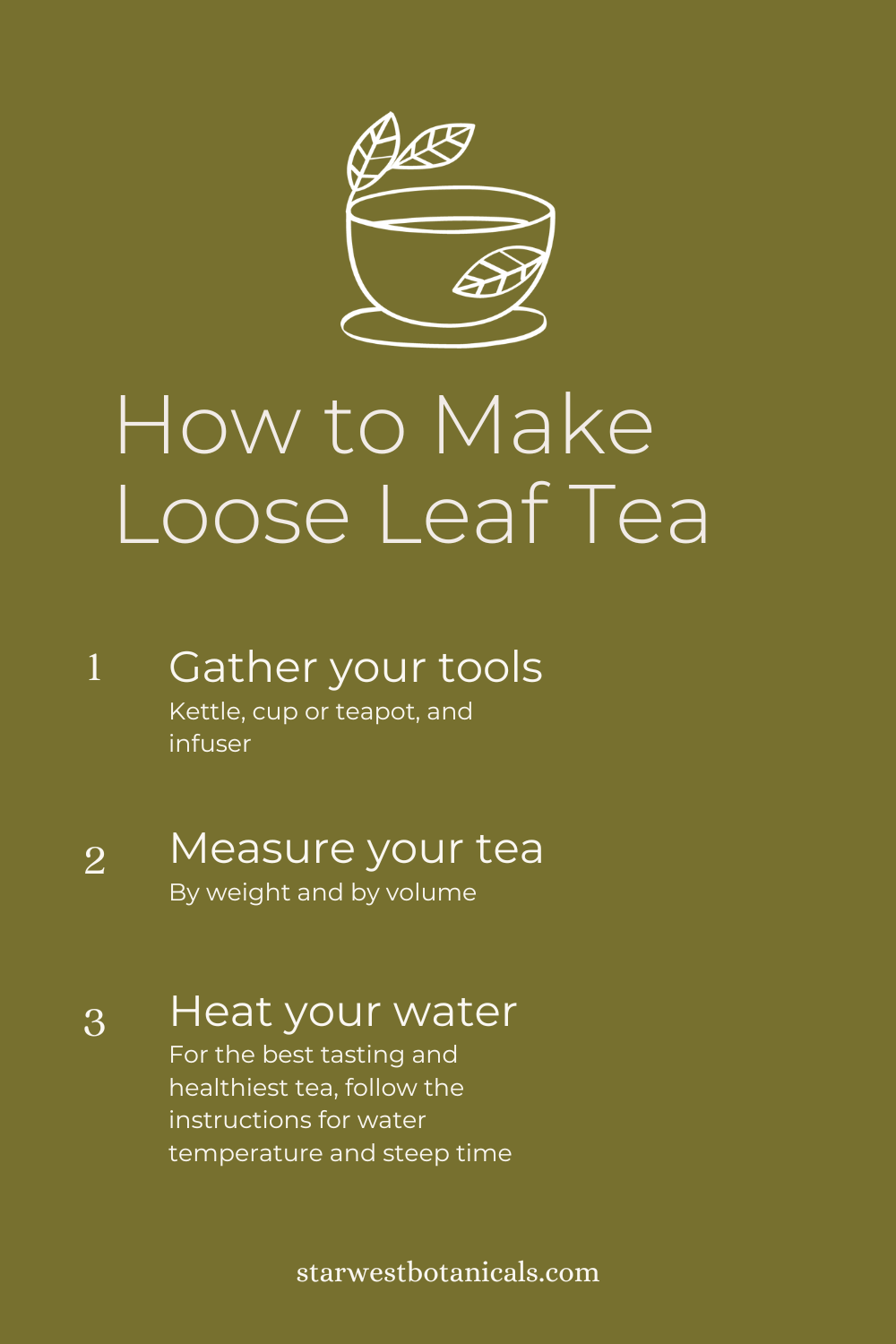How to Make Loose Leaf Tea: A Guide | Starwest Botanicals
Posted by Starwest Botanicals Content Team | Medically Reviewed by Daniel Powers, MS on 07-11-2022

There’s nothing better than settling down in your favorite cozy chair with a good book and a piping hot cup of tea. You breathe in the warm scent of your favorite brew, turn the page, and bask in the feeling of true relaxation.
What’s more, your options for tea are just as diverse as the paperbacks on your bookshelf. You’ll find it in caffeinated and non-caffeinated varieties, or in tea-bag and loose-leaf form. As a bonus, sipping on a cup of your favorite tea may even provide some health benefits since its often rich in antioxidants.
You might even be itching to make a cup of your favorite tea right now. This guide will walk you through how to brew loose leaf tea—from the set-up to that first delightful sip.
How to Brew Loose Leaf Tea: Before Your Pour
If you are a tea drinker who has only had brewed tea from a tea bag and are now ready to venture into organic loose leaf tea, you’re in for a treat. Tea bags typically contain smaller particles of tea leaf and other ingredients. In contrast, loose leaf teas are made from unbroken, whole tea leaves.
There are several advantages to using loose tea instead of tea bags, including:
- The tea is typically of higher quality
- It’s better for the environment since tea bags aren’t usually compostable
- Many people claim loose leaf tea tastes better
However, brewing loose leaf vs tea bags does require a few extra tools. So, let’s look at what you’ll need to do before you pour your hot water over your tea.
Step #1: Gather Your Tools
For your first step, you should gather all of the implements you need to make your tea. There are three key tools you’ll need in order to brew a tasty cup of loose leaf tea. These include:
- Kettle – Your tea kettle will help you heat your water to the perfect temperature. You can use an electric kettle or a traditional stovetop one—it’s really a matter of preference or whatever you have on hand.
- Cup or teapot – You’ll also need a vessel to brew your tea in. This can be a mug or tea cup if you’re brewing a single serving. If you want to make a full pot of tea for more than one person, then a teapot in the appropriate size will work nicely.
- Tea infuser – Finally, you’ll need a tea infuser. The infuser, or tea strainer, is where you’ll put the tea so it can steep in the hot water without leaving little bits of tea leaves in your cup. Tea infusers come in a wide range of shapes and sizes. Some teapots even come with a built-in infuser for easy use.
Can You Make Loose Leaf Tea Without An Infuser?
While a tea infuser makes brewing loose leaf tea a little easier, you can still enjoy your tea without one. There are several other methods you can use to strain your tea, such as:
- Two cups—brew the tea in one cup and pour through a sieve into the second
- Brew in a paper coffee filter
- Brew and fish the leaves out with a slotted spoon
- Use a french press coffee maker
- Make your own infuser with tin foil by punching a few small holes in it
Any of these methods will do in a pinch when brewing tea. That being said, infusers are relatively inexpensive and can be used over and over again, making them an eco-friendly choice.
Step #2: Measure Your Tea
Once you’ve gathered everything you need, it’s time to measure the amount of tea you need for your perfect cup or pot. There are two different ways you can measure your tea:
- Measuring By Weight – If you’ve got a small kitchen scale on hand, you can use it to ensure you’re using the right amount of tea. A general rule you can follow? Combine between 2–3 grams of tea per 6–8 ounces of hot water.
- Measuring By Volume – You can also skip the scale and use a teaspoon to measure your tea. One teaspoon is appropriate for about six ounces of water, while a heaping teaspoon is more appropriate for an eight-ounce cup.
It is important to have the right amount of tea. Too much can leave you with a bitter-tasting cup while too little won’t have the potent flavor you want.
Step #3: Heat Your Water
After you’ve measured your tea leaves, proceed by heating your water. Begin by adding cold, filtered water to your heating device.
If you’re using an electric kettle, it’s easy to monitor the temperature of the water. Most modern electric kettles come with a handy temperature control knob that makes it a breeze. A stovetop kettle is a little tougher to manage as you’ll need to keep an eye out for:
- When the water begins to steam for lower brewing temperatures
- Those first few bubbles before a full boil
- The rollicking, full boil that causes the kettle to scream
The reason you need to pay such close attention to the water is that different tea varieties require certain water temperatures for optimal brewing. These can range from as low as 140 degrees all the way up to 212 degrees Fahrenheit.
Why Is Water Temperature Important for Tea Brewing?
You might be wondering if it’s really that important to get the water temperature just right when you make a cup of loose leaf tea. It might seem like a minor detail but the water temperature can impact the:
- Taste of your tea
- Efficacy of the phytochemicals in your tea
- Amount of caffeine your tea contains
So, for the best tasting and healthiest tea, you should always follow the instructions for water temperature and steep time for the specific type of tea you’re making.

Making the Perfect Cup of Loose Leaf Tea
Each tea type requires a little special care for it to turn out just right. The following instructions will provide you with the specifics on how to make loose leaf tea, specifically hot tea, perfectly every time you brew:
- Black tea – Loose leaf black tea requires water that’s between 185–195 degrees Fahrenheit. Measure one teaspoon of tea per eight ounces of hot water. It is recommended to steep loose leaf tea for 3–4 minutes.
- Chai tea – If you love spicy, flavorful tea, then you’ll enjoy chai. To brew, you should heat your water to boiling (212 degrees Fahrenheit). Use one teaspoon of tea per eight ounces of boiling water. Allow the tea to steep for 4–5 minutes. Many people enjoy chai tea with additions like milk, honey, black pepper, or nutmeg.
- Flowering tea – Flowering teas are made by wrapping tea leaves around a dried flower or flowers. To brew this special tea, heat your water to just below boiling. Put one tea bud into a tea infuser. Then, pour eight ounces of hot water over the tea bud. Let it steep for 3–5 minutes. You can reuse the same tea bud up to three times without sacrificing flavor.
- Green tea – Green tea is more delicate than black tea and requires cooler water and less steep time. Your water should be heated until it’s just beginning to simmer (about 180 degrees Fahrenheit). Measure one teaspoon per 8–12 ounces of hot water. Steep your green tea leaves for 2–3 minutes and enjoy.
- Herbal tea – Herbal teas come in a wide variety of flavors and are caffeine-free. For optimal brewing, heat your water to 212 degrees Fahrenheit. Pour between 8–12 ounces of boiling water over one teaspoon of loose herbal tea. Steep for 3–4 minutes.
- Matcha tea – Matcha tea is made by grinding young tea leaves into a fine, bright green powder. Unlike other teas, matcha isn’t steeped. Instead, you should heat six ounces of water to between 175–180 degrees. Measure one teaspoon of matcha powder into your cup. Pour the hot water over the powder while stirring to dissolve it.
What Should You Look for When Tea Shopping?
Not all tea is created equal. We’ve already established why loose leaf tea is beneficial but there are varying levels of quality, even for loose leaf teas. To ensure that you’re getting the best, look for loose leaf teas that has the following attributes:
- USDA Certified Organic or Fair Trade certified
- Come in a tightly sealed container to prevent moisture from getting in
- Includes a combination of organic herbs, spices, flowers, and other ingredients
Remember, the quality of your loose leaf tea leaves will also significantly impact the flavor and efficacy of the tea’s active constituents. The best way to ensure the quality of your tea lasts is to learn how to store loose leaf tea properly.
The Perfect Cup Starts with Starwest Botanicals
Making a cup of loose leaf tea is a wonderful way to kick back and relax. You get to treat your body to something that tastes good and is good for you. Loose leaf tea is often preferred to bagged tea because of its superior quality and taste. The only heavy lifting you’ll need to do is measure your tea-to-water ratio properly and follow the appropriate temperature and steeping directions.
At Starwest Botanicals, we know you deserve the best brew. That’s why many of our teas are certified organic and fair trade certified. You’ll love the variety we offer and, most importantly, the quality. Check out our selection today and get ready to drink your best cup of tea yet.
Sources:
PubMed. Tea Polyphenols in Promotion of Human Health. https://pubmed.ncbi.nlm.nih.gov/30585192/
PubMed. Influence of Tea Brewing Parameters on the Antioxidant Potential. https://www.ncbi.nlm.nih.gov/pmc/articles/PMC8400668/


